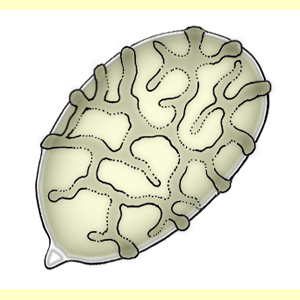
To establish if spore ornamentation is present, spores must be examined at high magnification (x1000). To interpret the type of spore ornamentation, a number of spores should be examined. Ornamentation should be viewed on mature spores.
Spore ornamentation can be made more visible in certain mounting media, particularly Melzer's Reagent and Cotton Blue solution. Spore ornamentation may be destroyed in KOH solution.
At high magnification the depth of focus is very shallow, and it usually is not possible to have both the upper surface and margin of a spore in focus at the same time. Oil droplets in the inside of the spore can give the appearance of an ornamented surface, but careful focussing will show that the droplets are interior to the spore wall.
Choose this state if: the spore ornamentation is reticulate, consisting of a complete to incomplete network of shallow to deep ridges. The ridges can connect warts or spines. The ridges are usually narrow, or occasionally blunt and broad. Around the edge of the spore the ornamentation can appear spiny or warty, where ridges are viewed edge-on, but the surface view is always distinctly reticulate.
Another term used to describe this state is lacunose, or the ornamentation is described as a network or resembling honeycomb. If the spaces between the reticulation are emphasised, spores can be described as pitted or foveate.
